Urban Sidewalk Dynamics
Assessing the Relationship of Sidewalk Width and Pedestrian Activity in Auckland, New Zealand based on Mobile Phone Data
Chuang, I.-T., & Chen, Q. (2024). Urban street dynamics: Assessing the relationship of sidewalk width and pedestrian activity in Auckland, New Zealand, based on mobile phone data. Urban Studies, 0(0). https://doi.org/10.1177/00420980241293659.
This study empirically examines the adequacy of sidewalk widths in Auckland's Central Business District (CBD) in light of increasing active mobility and sustainable urban planning trends. Recognising the need to retrofit street spaces to prioritise pedestrian needs, we aim to determine whether current sidewalk dimensions meet the diverse requirements of users and align with sustainable urban goals. We analysed average sidewalk widths and developed four mobility metrics—travel distance of inflow and outflow movements, and density of visitors and locals—using a large-scale mobile location dataset comprising 113 million data points from 1.4 million users. These metrics, reflecting urban vibrancy and sidewalk use, were correlated with sidewalk widths to assess their adequacy. Furthermore, we applied cluster ranalysis to these mobility metrics, along with the diversity of Points of Interest (POIs), to categorise sidewalk segments, uncovering intricate usage patterns. Our findings indicate that sidewalks typically range from 2-5 meters, catering to varied urban needs. Notably, we observed no direct correlation between sidewalk width and mobility patterns, but significant differences in inflow and outflow travel distances were evident, especially between key urban hubs and quiet residential neighbourhoods. Moreover, we identified seven distinct sidewalk categories, each reflecting unique qualities, suggesting that uniform widths do not define sidewalk utility or character. This highlights the need to rethink current capacity-focused sidewalk design, advocating for a nuanced approach that addresses the intricate demands of urban spaces and diverse user needs. This methodology is flexible and can be tailored to suit different urban contexts, providing a versatile tool for urban analysis and planning.This methodology is adaptable for other cities, offering a universal urban analysis and planning tool.
Introduction
At the heart of the complex dynamics of urban spaces lies the infrastructure that shapes urban life, particularly streets used by both automobiles and pedestrians. Streets, traditionally viewed as conduits for movement, are increasingly recognised as dynamic, multi-dimensional spaces integral to the urban fabric (Gehl and Rogers, 2010). Contemporary urban planning and design discourse views streets as pivotal within sustainable urban development frameworks (Puchol-Salort et al., 2021; Wang et al., 2023), aligning their design with broader goals such as reducing environmental impact and encouraging environmentally friendly transportation modes like walking and cycling (Fields and Renne, 2021).
In this evolving urban landscape, sidewalks serve not just as pedestrian passages but as spaces that host activities like outdoor dining, street vending, and cultural expression (Kim, 2012; Lanza et al., 2022; Whyte, 1980). This multifunctionality enhances the quality of urban spaces for residents (Mehta and Bosson, 2021), supports commercial activities (Sevtsuk, 2020), mitigates the negative health and environmental impacts of motorised vehicles (Nieuwenhuijsen, 2020), and fosters inclusive and sustainable urban communities (Fields and Renne, 2021).
Amidst this backdrop, it is crucial to assess whether the existing sidewalk widths are sufficient, using Auckland’s Central Business District (CBD) as the case study – an area marked by rapid urbanisation and diverse user needs, presenting a unique opportunity to delve into the complexities of sidewalk provision. Our objective is twofold: first, to evaluate the adequacy of existing sidewalk widths in relation to pedestrian vibrancy; and second, to understand the broader implications of sidewalk dimensions on urban life.
The prevailing view suggests that well-designed, safe, and accessible sidewalks will naturally facilitate efficient movement patterns (Global Designing Cities Initiative, n.d.). However, this perspective, while valid, tends to oversimplify the complex relationship between the physical layout of urban spaces and human behaviour, not fully acknowledging that sidewalks not only facilitate but also influence and are influenced by pedestrian movements (Hillier, 1996). Addressing this gap requires establishing a comprehensive baseline of current sidewalk functionality and usage, which is imperative for future improvements to be effectively aligned with the evolving needs of urban communities.
Research on sidewalk performance has traditionally applied methods like observation surveys or interviews. While valuable, these methods are often limited in scale and are labour-intensive, making it difficult to gather data on a large scale (Lee et al., 2009; Mehta and Bosson, 2021; Suminski et al., 2008). Additionally, these methods can be subjective and prone to human error, further complicating the reliability of the data collected. The scarcity of reliable and cost-effective methods for collecting comprehensive sidewalk data limits our capacity to broaden the scope of research insights into pedestrian infrastructure networks.
Although sidewalk length can be easily measured through GIS mapping, measuring sidewalk width presents more significant challenges. Building setbacks, which can become extensions of the sidewalk space, add to the complexity of accurately measuring sidewalk width. This variability complicates the task of collecting consistent and reliable data on sidewalk dimensions. Consequently, the lack of scalable and efficient methods to measure sidewalk width hinders researchers’ ability to analyse and understand the intricate interactions between sidewalk design, pedestrian behaviour, and urban mobility patterns.
Due to these challenges, many researchers have prioritised the development and application of innovative data collection methods. Techniques such as image sensing and AI detection, utilising aerial photos and Street View images from platforms like Google Street View (Psyllidis et al., 2023), offer promising solutions by enabling large-scale, objective, and efficient data collection and analysis (Hara et al., 2013; Salazar Miranda et al., 2021). These advanced methods can significantly enhance the thorough understanding of pedestrian infrastructure networks, providing a more accurate and holistic view of urban pedestrian environments.
Similarly, our study employs advanced technological approaches to assess pedestrian infrastructure. Specifically, we leverage geolocation data and GIS topographical information to explore the relationship between sidewalk width and its vibrancy by analysing human mobility patterns. This approach provides a nuanced understanding of pedestrian behaviour that challenges the conventional focus on width and capacity.
Ultimately, this research aims to provide a foundational empirical evaluation of current sidewalk performance in relation to its physical dimensions. By shedding light on the complex interplay between urban infrastructure and pedestrian dynamics, it will foster the ongoing development of sustainable, human-centred urban environments and the creation of resilient and inclusive urban communities.
Sidewalks as urban catalysts: Their evolution and influence on city life
This study acknowledges sidewalks as critical urban catalysts. The lively pedestrian traffic on sidewalks symbolises thriving urban spaces, showcasing their intricate and multifaceted nature (Amato, 2004; Brown-May, 1998). Traditionally, sidewalk design adhered to prescriptive standards set by governmental regulations or design guidelines, focusing on minimum dimensions based on anticipated pedestrian flow and adjacent land use (Blomley, 2010). These standards, developed by urban engineers in cities like Paris and London in the late 19th and early 20th centuries, sought to regulate sidewalks as discrete spaces under municipal control, sometimes compromising their multifunctional nature (Ben-Joseph and Szold, 2004; Fairfield, 1994).
The introduction of the Level of Service (LOS) concept, originally a traffic management metric, into pedestrian planning signified a pivotal shift towards comprehensive evaluation of sidewalk functionality (Polus et al., 1983). Documented in Fruin’s ‘Pedestrian Planning and Design’ (Fruin, 1970) and the United States Highway Capacity Manual (HCM, 1950), this transition marked a move away from a purely regulatory focus towards a more human-centric planning approach (Campisi et al., 2023; Raad and Burke, 2018). This newer perspective embraced both quantitative measures and qualitative factors such as accessibility, safety, connectivity, aesthetic quality, and the availability of amenities (Lee et al., 2009; Vallejo-Borda et al., 2020), signalling a holistic reimagining of pedestrian spaces.
For quantitative measures, sidewalk research has predominantly employed network analysis. Features such as street connectivity, land use diversity, and physical attributes like width, street furniture, green spaces, and walking surface quality directly impact a pedestrian’s comfort and overall experience (Forsyth et al., 2007; Im and Choi, 2019). These factors are widely recognised as key indicators for evaluating and improving pedestrian networks (Chuang et al., 2023b; Gaglione et al., 2021; Pearce et al., 2021). High connectivity and centrality in pedestrian networks enhance walkability by offering multiple route choices and accessible major destinations, respectively (Carpio-Pinedo et al., 2014; Lindelöw et al., 2017; Lundberg and Weber, 2014). Betweenness centrality indicates critical nodes for maintaining network connectivity, while closeness centrality reflects efficient access, both of which contribute to increased pedestrian activity (Jiang and Claramunt, 2004; Sabidussi, 1966). Visual analysis techniques like space syntax and GIS provide comprehensive evaluations of urban spaces, aiding in the prediction and enhancement of pedestrian movement patterns (Batty, 2022; Yang and Qian, 2023). These methodologies underscore the importance of well-designed and connected pedestrian networks in promoting walkability and sustainable urban development. However, this research often does not include a reflective assessment of sidewalk utilisation. Many studies do not capture real-time sidewalk usage.
It is also increasingly acknowledged that perceived qualities deeply shape walking behaviours (Vallejo-Borda et al., 2020). These subjective experiences, influenced by aspects such as safety, comfort, and aesthetics, are intimately linked to the physical features of sidewalks (Lee et al., 2009). Recognising the intricate interplay between perceived (qualitative) and measurable (quantitative) sidewalk qualities (Gao et al., 2022), contemporary urban planning discourse advocates for a design approach attuned to distinct needs and characteristics of various urban contexts. This approach emphasises the need for context-specific methodologies that resonate with different neighbourhoods’ unique rhythms and nuances (Gebel et al., 2011).
The more current discourse on sidewalks has evolved to encompass dynamic variables and the multifaceted nature of urban streets, adding layers of complexity to the understanding and management of these spaces (Gao et al., 2022; Salazar Miranda et al., 2021). The growing popularity of active transportation modes, such as cycling and walking, has prompted discussions about the design of shared street spaces within urban environments. While shared spaces foster benefits like enhanced social interaction and improved pedestrian safety, they also bring challenges. Potential conflicts may arise due to the coexistence of pedestrians with other users moving at different speeds, affecting perceived comfort and safety within these shared spaces (Gkekas et al., 2020; Ruiz-Apilánez et al., 2017).
In response to these evolving dynamics, our research delves into the complex nature of sidewalk spaces, leveraging mobile phone data to provide a more detailed and granular perspective of pedestrian behaviour. Utilising mobile phone data can reveal real-time pedestrian movement and behaviour, offering a more realistic picture. However, it is important to acknowledge the significant ethical and representational issues associated with mobile phone data, such as privacy concerns and potential biases in the data sample. These limitations are crucial, and methodological strategies need to be applied to ensure privacy, ethics, and the mitigation of biases, such as anonymising data and employing robust sampling techniques to ensure representativeness.
Our study seeks to bridge the gap between theoretical insights and practical applications, advocating for a nuanced, context-sensitive approach to sidewalk design. By thoroughly analysing pedestrian movement patterns, urban context and the diversity of Points of Interest (POIs), we aim to refine sidewalk categorisation, achieving a more harmonious physical, social, and functional balance. This research aims to provide valuable insights into the urban streetscape, contributing to a more informed enhancement of a unique and pedestrian-friendly urban environment.
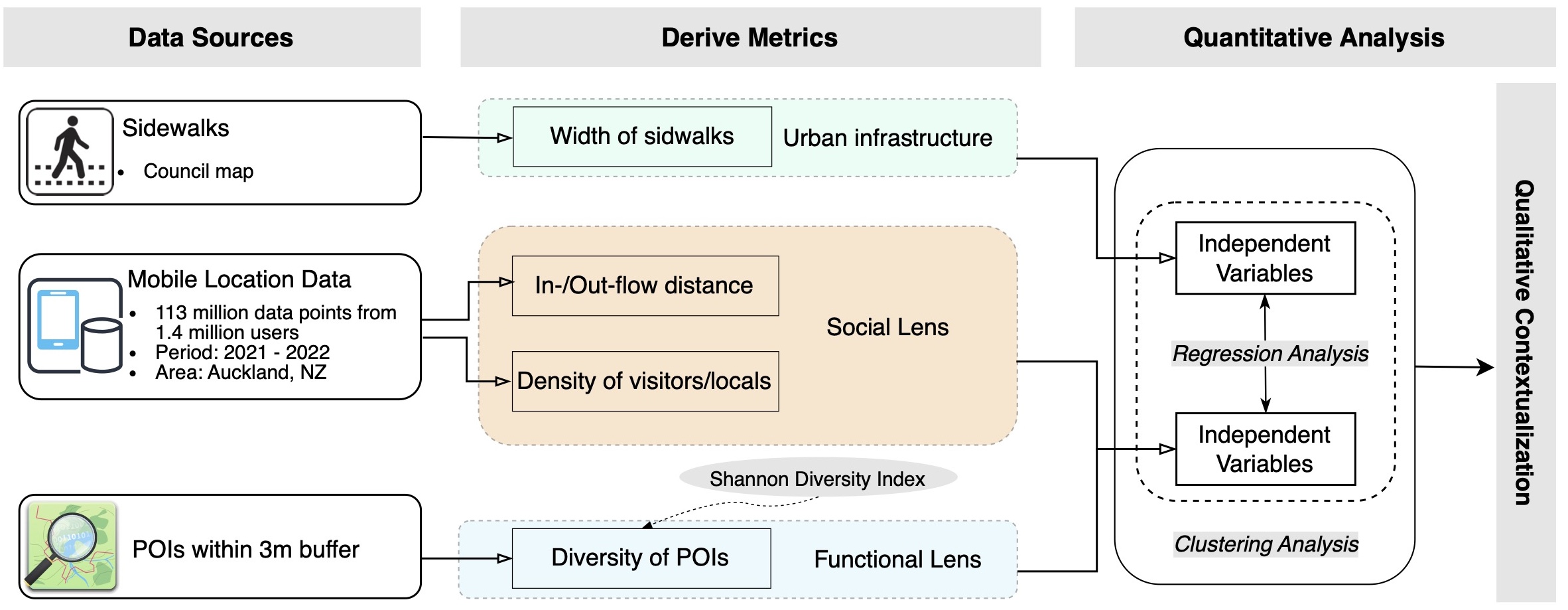
Sidewalks width calculation
The assessment of sidewalk width utilises digitised roadway kerb lines and property parcel boundaries, as provided by the Auckland Council (Geodata Hub, 2020), which precisely outlines the full extent of all sidewalk areas. To ensure a more detailed analysis, sidewalks within the same block were subdivided into various segments, as illustrated in Figure 2. This segmentation acknowledges that different sections of the sidewalk may exhibit varied characteristics, leading to differential usage frequencies across segments within the same block.
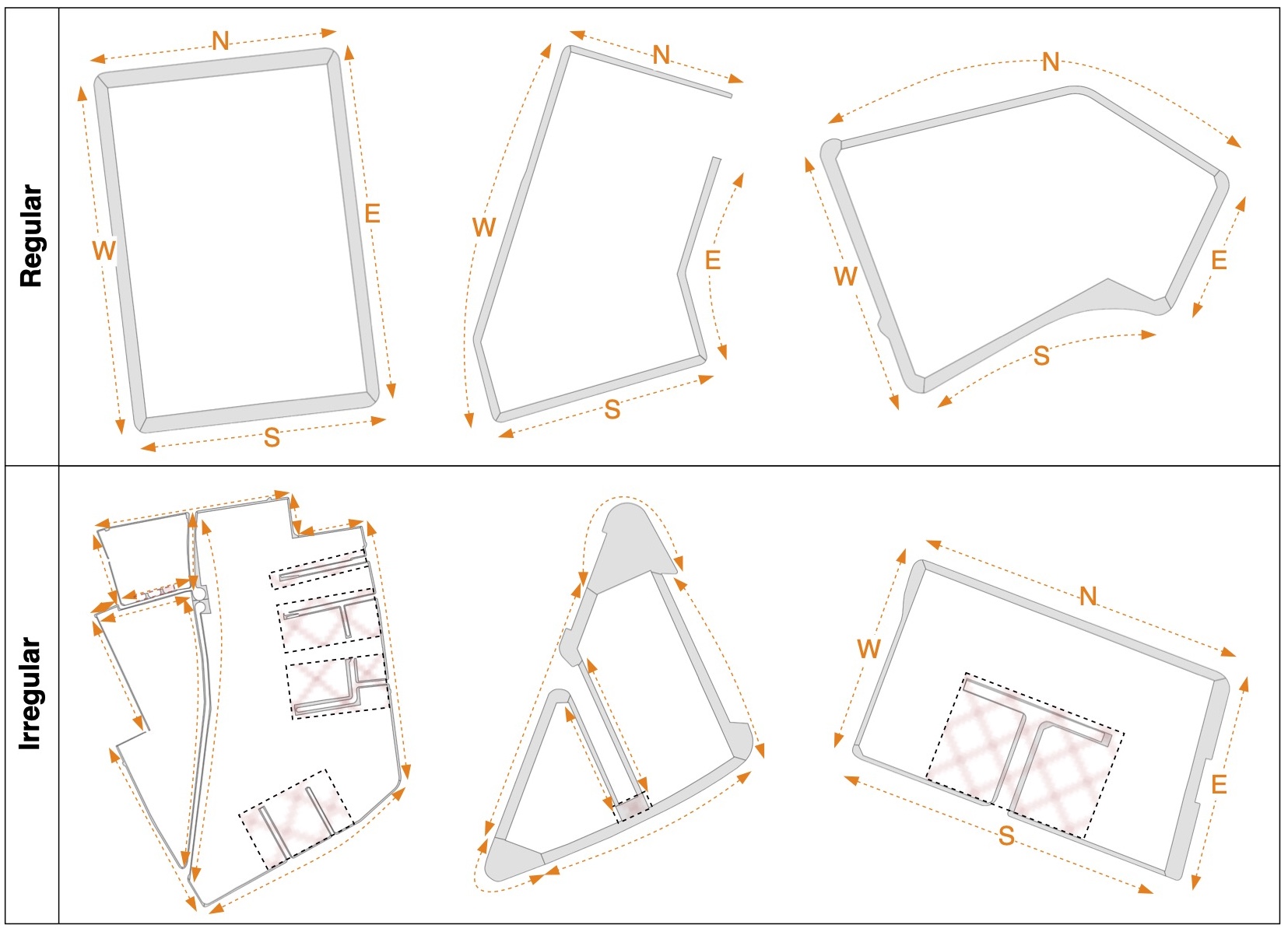
For practical analysis, sidewalks are segmented into four directional parts: West, East, North, and South. In dealing with sidewalks with non-standard shapes, our focus remains on those that run alongside roads, deliberately excluding side alleys to ensure consistency in our measurements. For larger areas, like wide corners, each was considered an independent segment to mitigate any disproportionate influence on the overall accuracy of sidewalk width measurements. This process resulted in a total of 2269 sidewalk segments.
Subsequent to segmenting the sidewalks, one edge of each segment was transformed into a sequence of points set at 5 m intervals. This technique permitted the measurement of the distance from each point to the opposite edge of the segment, thus determining the width at specific locations. The average width of each segment was then computed based on these individual measurements (Psyllidis et al., 2023). The calculated average width of segments facilitates a more granular understanding of different usage patterns and serves as the dependent variable for subsequent regression analysis.
Mobility metrics measures – social and functional
To comprehend the social aspect of sidewalks, we developed mobility metrics under a social lens: In flow Distance, Out flow Distance, Density of Visitors and Density of Locals. These were constructed by forming the ‘home-to-destination’ (OD) network for each user. These metrics were carefully chosen for their potential to offer profound insights into pedestrian behaviour and sidewalk utilisation, providing a clear view through a social lens and illuminating the preferences and behaviours of different pedestrian subgroups.
- In-flow Distance measures the average travel distance of visitors, specifically charting their movement from the centroids of their home locations to the centroid of the visited neighbourhood.
- Out-flow Distance evaluates the travel distance of locals from the home neighbourhood centroid to the centroids of all other neighbourhoods.
- Density of Visitors quantifies the number of non-local individuals frequenting a sidewalk, reflecting its popularity or functionality to a wider audience.
- Density of Locals provides a count of local residents utilising the sidewalk, offering a glimpse into the sidewalk’s role and utility in the daily lives of the local community.
- Diversity of Points of Interest (POIs): For the functional aspect of sidewalks, we concentrated on the Diversity of POIs within a 3m buffer surrounding each sidewalk.
Results
The mean sidewalk width in Auckland’s CBD is approximately 4.3m, with a 2–5m common range. Our findings reveal that broader sidewalks are often associated with key urban nodes like Viaduct Harbour, Queen Street, and historical routes such as Hepburn Street (see Figure 3(a)). This pattern is consistent with global urban design guidelines that advocate for wider sidewalks in areas experiencing higher pedestrian volumes and vehicular speed. (Committee on Highway Capacity, 1950; Polus et al., 1983). However, notable deviations exist, such as ‘High Street’, a bustling narrow street parallel to Queen Street with very narrow sidewalks, which, despite its constraints, is undergoing transformation through the High Street Pilot Project aiming to enhance accessibility and prioritise pedestrian space. This reflects the challenges and complexity of developing pedestrian infrastructure as underscored by the Waka Kotahi NZ Transport Agency (2020), suggesting that the current sidewalk widths may not fully meet the diverse needs of pedestrians and underlining the inadequacy of a one-size-fits-all approach in sidewalk design.
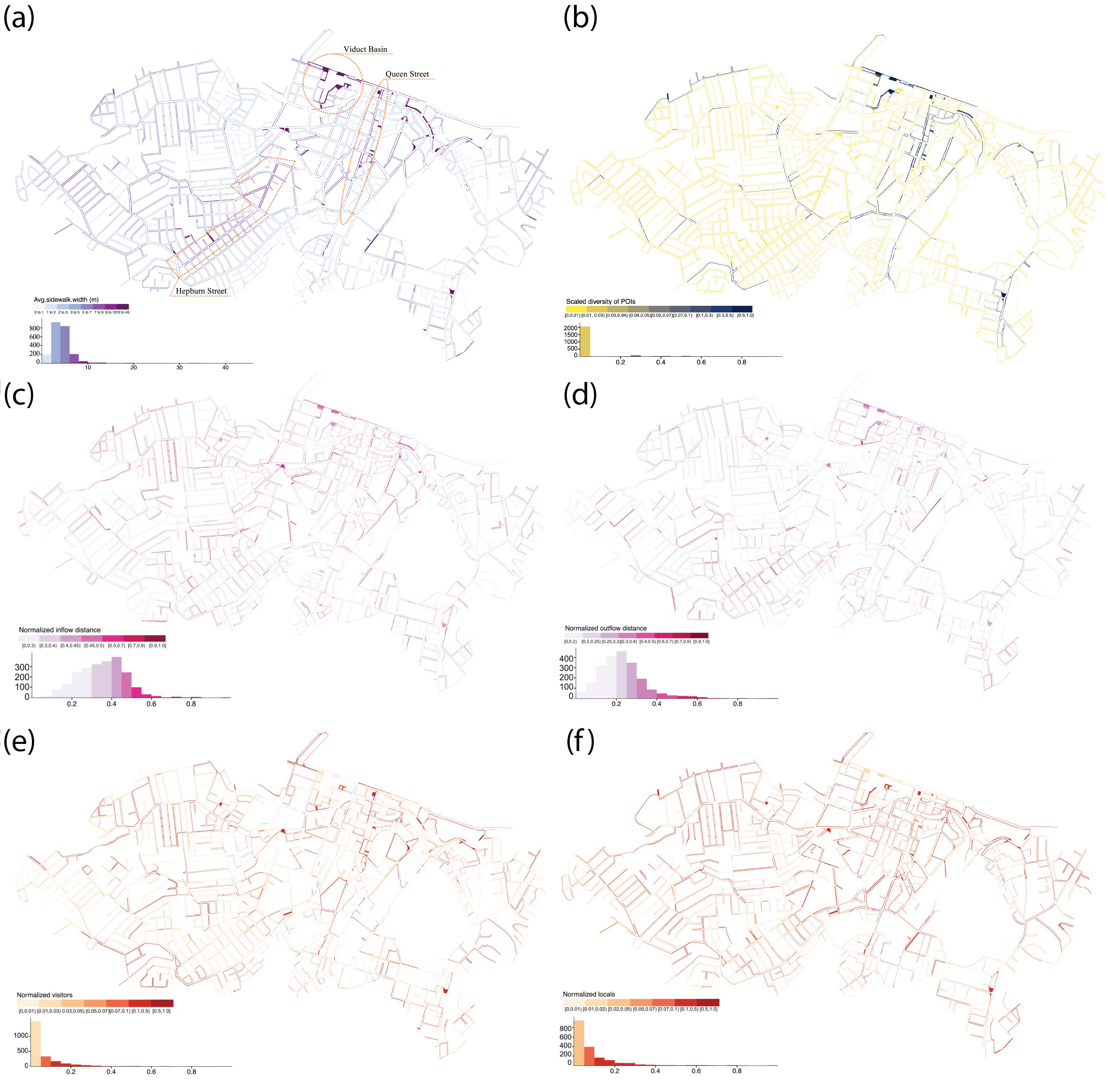
The metrics reveal that larger inflow travel distances indicate visitors travelling more to reach certain destinations, particularly in downtown areas such as Viaduct Harbour and Queen Street. This observation aligns with sociological theories regarding the distance effect (Dennis et al., 1999), suggesting that travel costs rise with distance, thereby influencing an individual’s preference based on the value-space distance. These factors can impact the attractiveness of sidewalks and reflect broader market dynamics, including the competitive landscape among destinations. Although our metric cannot detect the exact motives, sidewalks that register higher inflow distances are likely to possess attributes that draw more visitors, enhancing the vibrancy and dynamism of the area.
On the contrary, extensive outflow travel distances imply that residents tend to travel further from their homes for various activities, which can indicate lower walkability. This is contrary to the principles of walkability, which emphasise shorter travel distances to amenities, promoting health and environmental benefits (Forsyth, 2015; Gao et al., 2022). Furthermore, such travel patterns do not align with the concept of ‘15-minute cities’ which aim to ensure that most daily necessities and services are accessible within a 15-minute walk or bike ride from home, fostering more sustainable and liveable urban environments (Chuang et al., 2023a; Weng et al., 2019). This suggests that areas with extended outflow travel distances might lack essential local services. Our analysis particularly highlights higher outflow patterns in Viaduct Harbour and Queen Street areas, both of which are also known for high inflow travel distances that attract visitors to high-profile destinations (Figure 3(d)). This implies that a popular urban hotspot does not necessarily meet the needs of local residents. However, shorter outflow travel across neighbourhoods generally indicates well-serviced local areas, especially those nestled among the CBD’s street blocks, underscoring their potential to support daily essentials and promote walkability.
The analysis of footfall density (Figure 3(e) and (f)) shows that residential neighbourhoods typically attract fewer visitors compared to locals, while key arterials and mixed-use zones like Viaduct Harbour register a higher number of visitors. Notably, the local footfall density across the city, particularly at waterfront promenades and residential zones, displays a uniform high-value pattern. This finding is particularly noteworthy in a predominantly car-centric society like New Zealand (Mohammadzadeh, 2021), potentially influencing sidewalk usage patterns.
In our POI diversity analysis, we observe that areas boasting a broad array of POIs, such as Queen Street and the Quay Street waterfront, are generally expected to be bustling visitor destinations (Figure 3(b)). However, this does not invariably translate into higher visitor footfall, indicating a potential disconnect in leveraging urban amenities to foster pedestrian activity in Auckland City walking areas.
While it is commonly understood that sidewalk width alone cannot determine the vibrancy or the ability of urban spaces to meet pedestrian needs, our mobility matrix and POI diversity analysis empirically reinforce this notion. The findings reveal that although wider sidewalks are often found in busier areas, they do not directly correlate with increased vibrancy or pedestrian satisfaction. Instead, these counterintuitive findings suggest rethinking sidewalk adequacy and adopting a nuanced design approach, considering various urban dynamics and the diverse needs of pedestrians. In summary, our research highlights the complexity of developing effective pedestrian infrastructure and underscores the inadequacy of a one-size-fits-all approach in sidewalk design.
We further explore the characteristics of sidewalks comprehensively using cluster analysis. This method will statistically reveal clusters of sidewalks with similar characteristics, enabling us to uncover patterns of commonality or difference across areas and the factors contributing to those patterns. Figure 4 illustrates the spatial distribution of the classified clusters of sidewalks. The cluster analysis has identified seven distinct categories that blend physical, social, and functional elements, offering a comprehensive view of various urban areas (see Fig.5). Each category reflects unique urban characteristics:
- Vibrant Urban Hub (C1): Moderately wide sidewalks, highly variable local and visitor density, good connectivity, and consistent POI diversity.
- Quiet Residential Area (C2): Narrower sidewalks, lower local and visitor density, higher inflow distance indicating less accessibility, and minimal POI diversity.
- Tourist Magnet District (C3): Very wide sidewalks, variable local density, highest visitor density, moderate accessibility, and variable POI diversity.
- Suburban Retreat (C4): Wider sidewalks than C2, low local and visitor density, shortest inflow distance, and minimal POI diversity.
- Balanced Urban Locale (C5): Moderately wide sidewalks, higher local density, high visitor density, moderate distances, and slightly varied POI diversity.
- Dense Local Community (C6): Sidewalk widths like C1 and C5, highest local density, high visitor density, lowest accessibility, and minimal POI diversity.
- Tranquil Suburbia (C7) : Similar to C2 in sidewalk width and density, moderate inflow distance, higher outflow distance, and extremely low POI diversity.
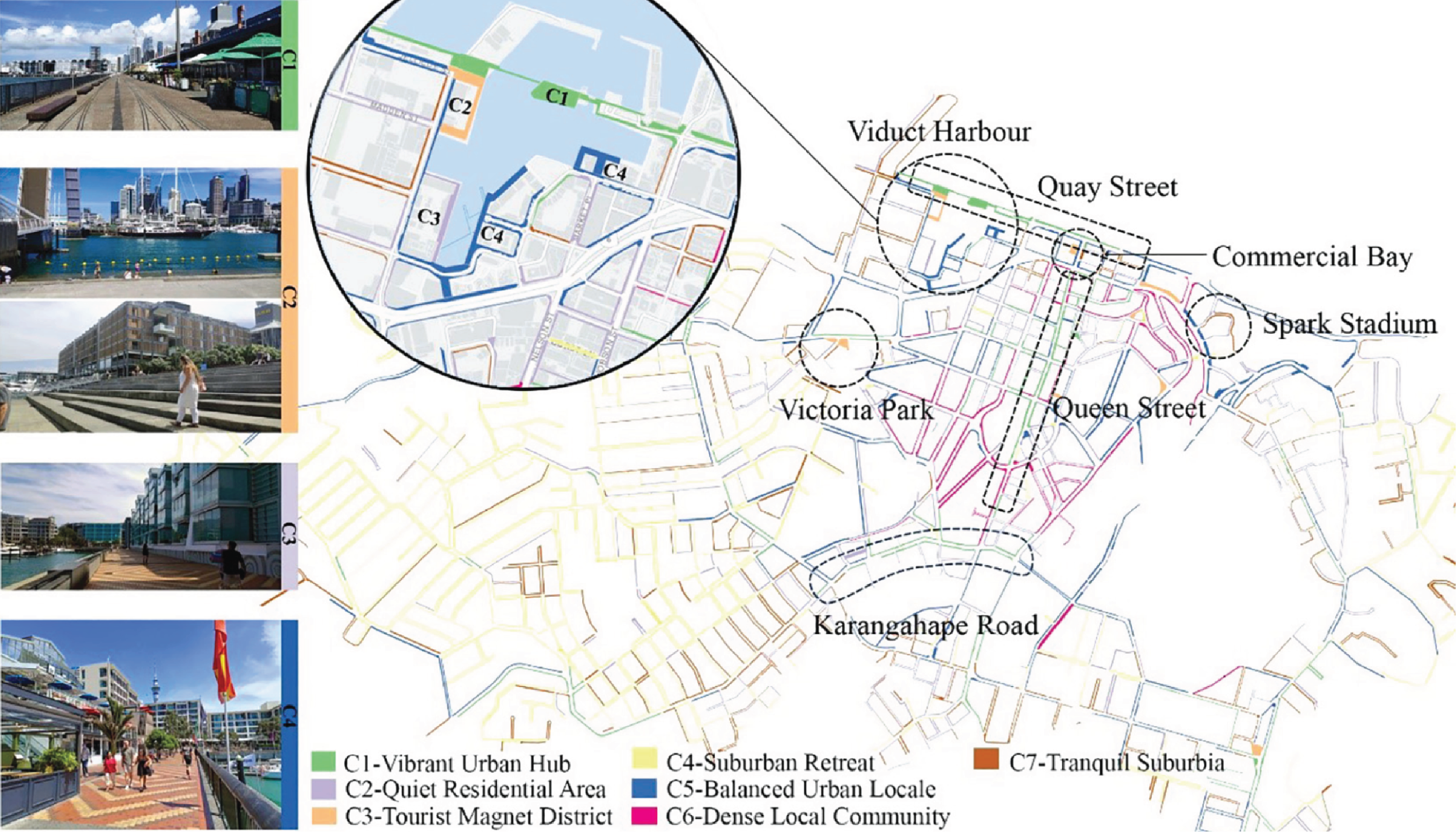
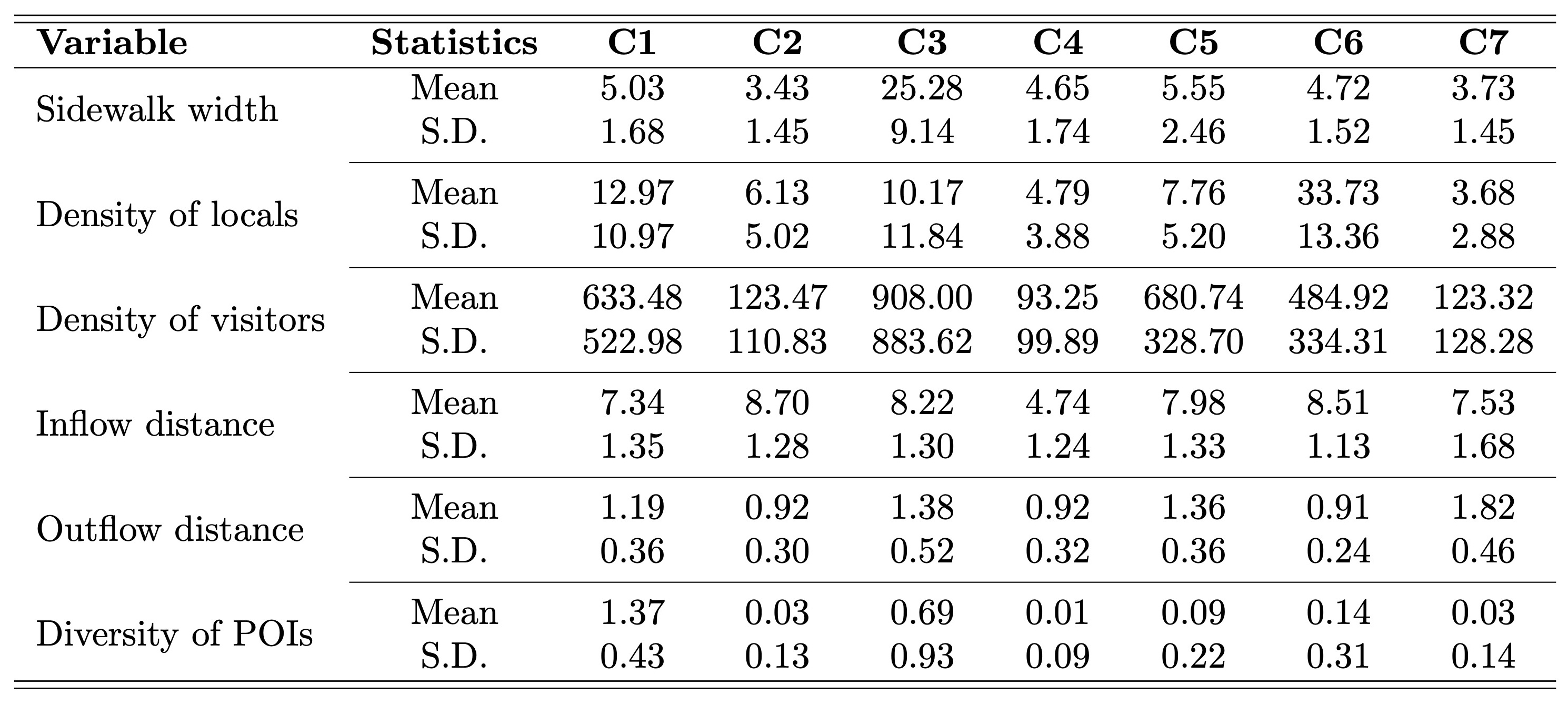
The clusters reveal a nuanced landscape of urban environments, where similar sidewalk widths can serve vastly different urban functions and cater to diverse populations and activities. For instance, the Vibrant Urban Hub (C1) and the Balanced Urban Locale (C5) both feature moderately wide sidewalks. Despite this similarity, C1 is characterised by highly variable local and visitor density and consistent POI diversity, suggesting a dynamic environment conducive to both social and economic activities. In contrast, C5, while also supporting higher local and visitor densities, offers a slightly varied POI diversity, indicating a blend of residential and commercial functions that might not be as intensely dynamic as C1 but still active.
Similarly, the Quiet Residential Area (C2) and Tranquil Suburbia (C7) share narrower sidewalks and lower densities, yet they differ in their accessibility and POI diversity, with C7 offering a slightly better connection to the surrounding areas despite its extremely low POI diversity. This suggests that while both clusters cater to quieter, more residential lifestyles, their interaction with the broader urban fabric varies. Interestingly, the Dense Local Community (C6) shares sidewalk widths similar to C1 and C5 but stands out due to its highest local density, minimal POI diversity, and low accessibility. This indicates a highly localised, dense residential area that, despite its sidewalk width, does not necessarily offer the vibrancy or accessibility of C1 or the balanced functionality of C5.
In addition, this categorisation also uncovered hidden patterns of the current urban landscape. For instance, the precinct of Viaduct Harbour, a success story in urban regeneration, has transitioned from an industrial/commercial hub to a vibrant, mixed-use space focused on leisure and recreation, becoming one of the most vibrant areas in the CBD. (NZ Herald, 2017). However, despite sidewalks being developed with consistent dimensions and quality, cluster analysis revealed four distinct sidewalk environments (Figure 4). The waterfront promenade (Cluster 1) displays vibrant urban activities, while areas inside the harbour with mixed-use, mid-density apartments (Cluster 5) exhibit balanced urban activities. Quieter residential areas along the harbour (Cluster 2) reflect serene residential life. The west end, known for panoramic views of the city and safe areas to interact with water, attracts both visitors and locals, fitting into Cluster 3 as a tourist magnet district. In summary, the analysis of sidewalk widths across different clusters reveals that similar infrastructure can underpin diverse urban experiences and functionalities.
However, it is crucial to acknowledge the inherent limitations of cluster analysis, such as the potential for oversimplifying complex urban dynamics and the influence of variable selection on the results. These limitations underscore the necessity for further localised, context-specific studies. Additionally, the use of mobile phone data presents several limitations regarding data privacy and representativeness.
Firstly, mobile phone data captures device movements rather than individual movements, introducing biases (Demšar et al., 2021). Variations in phone usage across demographics and regions can affect validity. This data may not accurately represent groups like children, the elderly or those without phones, limiting generalisability (Siła-Nowicka et al., 2016). The opt-in nature of data collection adds another layer of selection bias. High participation rates are crucial for effective contact tracing, but uneven participation can sustain transmission chains.
Such localised, context-specific studies can provide detailed insights into urban development strategies, ensuring that sidewalk designs are tailored to each area’s unique characteristics and aligned with broader urban planning objectives. In this manner, the analysis serves as more than just a tool for understanding the current state of sidewalks; it acts as a strategic guide for targeted improvements and informed urban development.